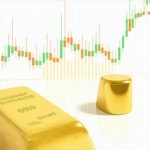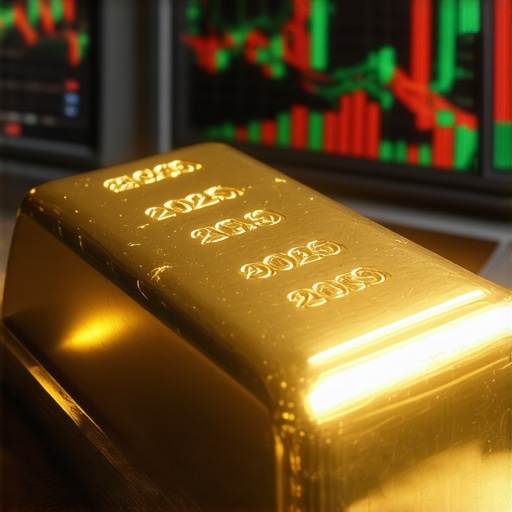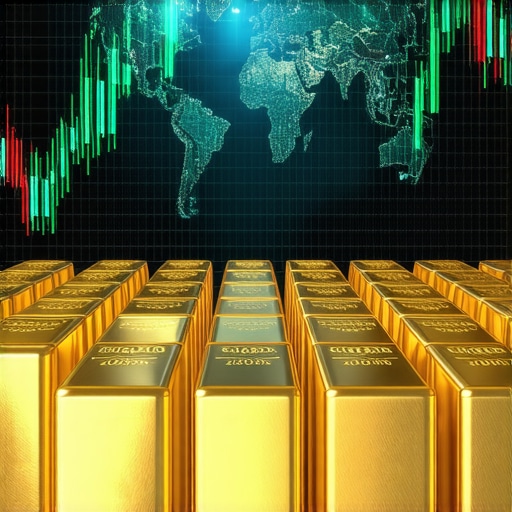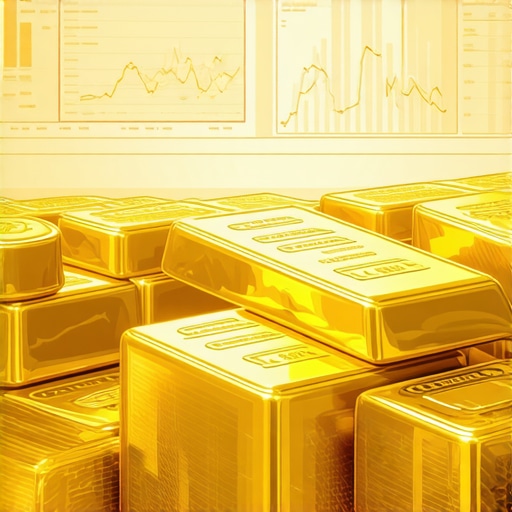The Role of Central Banks in Gold Price Fluctuations
Gold has long been considered a safe haven asset, and its value can be significantly influenced by the buying behaviors of central banks. As institutions responsible for managing a country’s currency and monetary policy, central banks play a pivotal role in shaping the dynamics of the gold market. Their purchases of gold not only impact the market price but also send signals to investors regarding economic stability and inflation concerns.
Understanding Central Bank Purchases
Central banks hold gold as part of their foreign exchange reserves, and their decisions to buy or sell gold can influence market perceptions. For instance, when a central bank increases its gold holdings, it often indicates concern about the stability of fiat currencies, leading investors to flock to gold as a secure alternative. This increased demand can drive up gold prices, creating a ripple effect throughout the market.
Recent Trends in Central Bank Gold Purchases
In recent years, we have seen a notable increase in the amount of gold purchased by central banks worldwide. Countries like China and Russia have been particularly active in expanding their gold reserves, which has been interpreted as a strategic move to reduce their reliance on the U.S. dollar. As central banks continue to accumulate gold, the overall demand in the market rises, contributing to price increases. For a deeper analysis of the implications of these trends, consider exploring the impact of central bank gold purchases on market dynamics.
Inflation and Economic Instability
Another factor that influences gold prices is the economic environment characterized by inflation and instability. When inflation rates rise, the purchasing power of fiat currencies declines, prompting investors to seek protection in gold. Central banks’ gold purchases can exacerbate this trend, as they signal confidence in gold’s value during uncertain economic times. This behavior can create a self-reinforcing cycle where increased central bank buying leads to higher gold prices, attracting more investors to the market.
Conclusion: The Future of Gold Prices Amid Central Bank Actions
As we look to the future, the influence of central bank purchases on gold prices remains a crucial aspect for investors to consider. Understanding the motivations behind these purchases and their potential impact on market dynamics will be essential for making informed investment decisions. For investors interested in diversifying their portfolios, learning about key indicators to watch in the gold market can provide valuable insights into future price movements.
The Impact of Global Events on Gold Prices
The price of gold is not only influenced by central banks but also by broader global events that can create economic uncertainty. Geopolitical tensions, natural disasters, and financial crises can all lead to fluctuations in gold prices as investors seek refuge in this precious metal. Understanding how these events affect the gold market is essential for investors looking to navigate the complexities of gold investment.
Geopolitical Tensions and Gold Demand
In times of geopolitical instability, such as conflicts or trade wars, investors often turn to gold as a hedge against uncertainty. The perception of risk associated with various regions can lead to increased demand for gold, driving its price higher. For instance, recent tensions in Eastern Europe have prompted investors to consider gold’s role as a safe haven, resulting in significant price movements. To gain insights into how to navigate these market conditions, investors can explore the role of gold demand in mitigating risk.
The Influence of Economic Indicators
Economic indicators such as inflation rates, interest rates, and unemployment figures can also significantly impact gold prices. When economic data shows signs of weakness, gold often becomes more attractive as an investment. For example, if inflation is rising, the purchasing power of currency diminishes, leading investors to seek the stability that gold provides. Monitoring key economic indicators can help investors make informed decisions regarding their gold investments.
Natural Disasters and Their Effects on Gold Prices
Natural disasters can disrupt supply chains and create economic uncertainty, which can also lead to fluctuations in gold prices. Events such as hurricanes, earthquakes, or pandemics can impact not only local economies but also the global market. During such times, gold often sees a surge in demand as a protective asset. Understanding how to assess the impact of these events on market trends is crucial for investors. For more detailed strategies, consider reading about conditions influencing future gold prices.
Conclusion: Preparing for Market Volatility
Investors should remain vigilant and prepared for the potential volatility in gold prices caused by global events. Staying informed about geopolitical developments and economic indicators can aid in making strategic investment decisions. By understanding the various factors that influence gold prices, investors can better position themselves in the market. For those just starting out, resources like a step-by-step guide to investing in gold can provide essential insights into entering this lucrative market.
Understanding Gold Price Fluctuations During Economic Crises
Economic crises can serve as significant catalysts for changes in gold prices. When financial systems face instability, many investors flock to gold as a safe haven, believing it to retain its value better than fiat currencies. This behavior is especially evident during stock market crashes when investor confidence sinks, prompting a surge in gold demand. To better understand how to navigate these situations, investors can review trends expected in 2025 for informed investment strategies.
Inflation: A Driving Force Behind Gold Investment
Inflation often leads to increased gold prices, as the metal is traditionally viewed as a hedge against the declining value of currency. When inflation rises, the purchasing power of money decreases, making tangible assets like gold more attractive. In periods of hyperinflation, gold prices can skyrocket as investors seek protection from currency devaluation. Keeping an eye on conditions influencing future prices can provide investors with a clearer picture of market movements.
How Central Banks Influence Gold Prices
Central banks play a pivotal role in the gold market through their buying and selling activities. When central banks purchase gold reserves, it often signals confidence in the metal, which can lead to price increases. Conversely, when they sell gold, it can lead to reduced prices. Investors should consider following key indicators in the gold market to stay informed on central bank actions and their potential impact on prices.
Technological Advancements and Gold Mining
Technological advancements in mining techniques can also affect gold supply and prices. Improved extraction methods can lead to higher yields and lower production costs, potentially decreasing gold prices if supply outpaces demand. Conversely, challenges in the mining sector, such as environmental regulations and resource depletion, can constrain supply and elevate prices. Understanding these dynamics is crucial for investors looking to optimize their portfolios. For a comprehensive overview, investors can read about different types of gold investments.
Conclusion: Adapting to Market Changes
As global events continue to shape the economic landscape, investors must adapt their strategies accordingly. By staying informed about geopolitical tensions, economic indicators, and central bank policies, investors can make well-informed decisions regarding their gold investments. For those new to the gold market, resources such as a quick guide for beginners can provide essential insights into entering this dynamic market.
Analyzing Current Gold Demand Trends
The demand for gold is influenced by various factors, including economic conditions, cultural significance, and investment trends. In recent years, there has been a noticeable shift in gold demand, driven by changing investor preferences and global economic uncertainty. For investors seeking to stay ahead, understanding these key indicators can provide valuable insights into potential market movements.
Emerging Markets and Their Influence on Gold Demand
Emerging markets, particularly in Asia, have shown a growing appetite for gold. Countries like India and China are major consumers of gold for both jewelry and investment purposes. As these economies continue to expand, their demand for gold is likely to increase, further shaping the global gold market. Investors should pay attention to future demand trends to make informed decisions.
The Role of Jewelry in Gold Demand
Jewelry remains one of the largest segments of gold demand, accounting for a significant portion of annual consumption. Cultural practices and traditions heavily influence gold jewelry purchases, particularly during festivals and wedding seasons in various countries. Understanding the cyclical nature of jewelry demand can help investors anticipate price movements. For a deeper dive, consider exploring investment options that align with these trends.
Investment Demand: The Shift to Gold ETFs
In recent years, there has been a marked shift from physical gold investments to gold exchange-traded funds (ETFs). Investors are increasingly utilizing gold ETFs as a more accessible way to gain exposure to gold without the need for physical storage. This trend highlights the growing preference for liquidity and ease of transaction. Investors interested in this shift should review the pros and cons of gold ETFs versus traditional gold investments.
Geopolitical Factors Affecting Gold Demand
Geopolitical tensions, such as trade wars and military conflicts, can create uncertainty, leading investors to seek safety in gold. Events like these often drive up demand, pushing gold prices higher. Keeping an eye on global relations and their potential impact on gold demand is crucial. For those interested in exploring this further, resources like market fluctuations can offer essential context.
Conclusion: Strategic Gold Investment in a Changing Market
As the gold market continues to evolve, investors must adapt their strategies to align with emerging trends and global events. By understanding the dynamics of gold demand, from cultural influences to investment trends, investors can position themselves for success. For comprehensive strategies, check out best practices for maximizing returns in a fluctuating market.
Frequently Asked Questions About Gold Demand and Investment
What are the main factors that influence gold demand?
Gold demand is primarily influenced by economic conditions, cultural significance, investment trends, and geopolitical factors. Economic stability can drive investor confidence, while cultural practices, particularly in countries like India and China, significantly impact jewelry demand.
How do geopolitical tensions affect gold prices?
Geopolitical tensions create uncertainty in the markets, prompting investors to seek safe-haven assets like gold. Events such as trade wars or military conflicts can lead to increased demand, driving gold prices higher as investors look for stability.
What role does jewelry play in gold demand?
Jewelry constitutes one of the largest segments of gold demand, with cultural traditions leading to significant purchases during festivals and weddings. This cyclical nature of jewelry demand can affect gold prices, making it essential for investors to understand these trends.
Are gold ETFs a better investment than physical gold?
Gold ETFs offer a more accessible and liquid way to invest in gold without the need for storage and insurance. However, each investment type has its pros and cons. Investors should evaluate their personal investment goals and risk tolerance when choosing between ETFs and physical gold.
What are the future trends for gold demand?
Future trends indicate that emerging markets will continue to drive gold demand. Additionally, the increasing popularity of digital assets and gold-backed cryptocurrencies may influence traditional investment methods. Investors should stay informed on these developments to make strategic decisions.
How can I track gold investment performance?
Investors can track gold performance through various financial news outlets, commodity exchanges, and dedicated investment platforms. Tools like gold price charts and expert analysis can provide valuable insights into market movements and trends.
What should I consider before investing in gold?
Before investing in gold, consider factors such as your investment goals, risk tolerance, and market conditions. Diversifying your portfolio and understanding the different forms of gold investments, such as coins, bars, and ETFs, is also crucial for strategic planning.
Is gold a good hedge against inflation?
Yes, gold is often viewed as a hedge against inflation. When inflation rises, the purchasing power of currency decreases, making gold a more attractive investment as it tends to retain its value over time. Investors often turn to gold during inflationary periods for stability.
How can I maximize my returns on gold investments?
To maximize returns, investors should stay informed about market trends, diversify their investments, and consider timing their purchases strategically. Regularly reviewing and adjusting their investment strategies based on market conditions will also help enhance returns.
Where can I find reliable information about gold investment?
Reliable information can be found on trusted financial news websites, investment platforms, and resources from expert analysts. Websites like the World Gold Council and reputable financial institutions provide valuable insights and market analysis.
Authority Resources for Gold Investment Insights
For investors looking to deepen their understanding of gold demand and investment strategies, consider exploring the following authoritative resources:
- World Gold Council – A leading organization providing insights and research on gold demand and investment trends.
- Investopedia – Offers comprehensive articles and guides on investing, including gold and other commodities.
- Kitco – A reliable source for live gold prices, news, and market analysis.
- Bloomberg Commodities – Provides in-depth market analysis, including information on gold investments.
- Forbes Investing – Features expert insights and strategies related to gold and other investment options.
Conclusion: Navigating the Gold Investment Landscape
In summary, understanding the dynamics of gold demand is crucial for successful investing. By keeping abreast of economic trends, cultural influences, and geopolitical factors, investors can make informed decisions. Gold remains a vital asset class, offering stability and potential returns amidst uncertainty. By leveraging the insights provided in this article, investors can strategically position themselves to navigate the evolving gold market effectively.











The article’s insight into central banks’ increasing gold purchases as a signal of economic uncertainty really stood out to me. I’ve noticed that when major economies like China and Russia boost their gold reserves, it tends to reflect a lack of confidence in traditional currencies, especially the U.S. dollar. This behavior seems to create a feedback loop where investors, seeing central banks accumulate gold, also rush to buy, pushing prices even higher.
From my own observations in financial markets, this trend suggests that central banks aren’t just passive players; their actions actively shape investor perceptions and market dynamics. It also makes me wonder about how transparency around these purchases affects market volatility. If more frequent and detailed disclosures were required, would it make the gold market more predictable or just add to speculation?
Given this dynamic, I’m curious how other investors interpret central banks’ gold buying signals. Do you see these purchases as a reliable indicator of upcoming economic instability, or do you think they sometimes overstate the risk? It would be interesting to hear how different perspectives influence investment strategies, especially in volatile times when gold’s role as a safe haven becomes even more critical.
Jessica raises some compelling points about the significance of central bank gold purchasing trends as signals of economic instability. From my perspective, these actions are certainly influential, but it’s essential to consider the broader context in which they occur. Central banks often buy gold as a hedge against geopolitical risks and currency devaluation, especially when confidence in fiat currencies diminishes. However, their buying patterns can sometimes be strategic rather than purely indicative of immediate economic crises. For instance, accumulating gold might be part of a long-term diversification plan rather than a reaction to current instability.
What I find particularly interesting is how transparency or the lack thereof around these purchases impacts market perception. Greater transparency might reduce volatility by providing clearer signals, but it could also lead to increased speculation if investors attempt to outguess central bank moves.
In your experience, how much weight do you personally give to central bank gold buying as a predictive tool? Have you observed periods where their actions diverged from market realities, leading to false alarms or missed signals? Exploring these nuances can help investors better interpret these cues in relation to other macroeconomic indicators.
The post provides a comprehensive overview of how central bank gold purchases influence market dynamics, and I find this topic particularly relevant in today’s climate where currency stability is constantly challenged. I personally have been tracking the gold reserve reports of major economies like China and Russia and noticed their increasing gold holdings over the past few years, which seems to suggest a strategic move rather than sheer economic panic.
What I find intriguing is how market participants interpret these signals—some see them as a warning of potential instability, while others view them as diversification tactics. Given recent geopolitical tensions, I believe that central bank moves could be more about hedging long-term risks rather than immediate market crashes.
Do you think that the transparency of these reserve changes could mitigate or exacerbate market volatility? I’d love to hear insights from others who have experienced or analyzed the impact of such disclosures on gold prices and investor confidence.